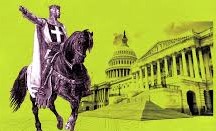Why Was Jesus Crucified
(The following is based on the latest scripture scholarship, particularly as it relates to first century Palestine. My primary source is Jesus: An Historical Approximation, by Jose A. Pagola, a Spanish scripture scholar and seminary professor. All quotes are his.)
Why was Jesus executed? Who made the decision?
These are perhaps the two most frequently asked questions concerning the historicity of this event. Unfortunately, the answers that were given to these questions for centuries have caused untold amounts of hatred towards the Jews, including pogroms, banishments, and ultimately the Holocaust.
John’s gospel is very strong in its denunciation of the “Jews”, which has tragically caused untold, however originally unintended, consequences. Hence, there is an urgent need for some clarification based on the latest scriptural developments, which, in turn, are now aided immensely by historical and archaeological findings.
From the Jewish point of view, the action against Jesus was clearly precipitated by the incident in the Temple in which Jesus drove out those who were selling and buying in the Jewish people’s holiest of places. He also overturned the table of the money changers and the seats of those who sold doves. Thousands of pilgrims would have been there, along with dozens of exchange tables and stands selling sacrificial animals. His gesture was probably small and limited, but it was full of prophetic power.
The problem was that any attack on the Temple was viewed as an attack on the heart of the Jewish people, the symbol around which everything else revolved. Any aggression against the Temple was a dangerous, intolerable offense, not only for the religious leaders, but for the whole people.
For Jesus, his act was a symbolic one. He used it to draw attention to something very important to him. His act is not aimed at liturgical reform, but at the elimination of the institution itself – an institution that had become an enormous organization, maintained by an oversized bureaucracy of officials, scribes, accountants, security police, and large priestly families. The priests were noted for living lives of luxury at the cost of the rural people.
In sum, the Temple had become a source of power and wealth for an aristocratic minority that lived at the cost of the weakest people. What Jesus in effect did was proclaim God’s judgment against an economic, political and religious system that represented everything that oppresses people. By his action, Jesus was proclaiming that the God of the poor and the excluded does not and will not reign from that Temple.
The Jewish leaders could not tolerate such an offense. Consequently, they set about finding the means of ridding themselves of his radical and highly disturbing presence.
From the Roman point of view, what we now call Palm Sunday was a turning point. Jesus made the decision to make the trip into Jerusalem at the time of the Passover on a donkey, as a symbolic act to proclaim God’s reign of peace and justice, in contrast to the Roman Empire which was built on violence and injustice. The crowds cheered him on. Then they began to cut whatever branches they found along the road; others laid out their tunics as he passed. It became a spontaneous act of homage by the disciples and followers of Jesus who had come with him. In Mark’s words, he is then acclaimed by “those who went ahead and those who followed.” Their cry was “Hosanna! Blessed is the one who comes in the name of the Lord.”
This entry into Jerusalem made Jesus appear as though he was a prophet, the bearer of a new and different order, in stark contrast to the one imposed by the Roman generals on their war horses. The Romans surely saw this parade as a mockery of the triumphal processions organized by the Romans to take possession of conquered cities. The people, they feared, could easily see this procession headed by Jesus as a criticism of the Roman prefect who had just ridden into the city on his powerful horse, adorned with all the symbols of his imperial power. The Romans were not amused. They decided he was committing the most heinous of crimes: stirring up the people; causing unrest and division among the populace. He was now a threat to the Empire.
The Romans never tolerated such a threat.
“As a public act proclaiming a nonviolent anti-kingdom, it would have been enough to lead to a decree of execution…. A man who publicly denounced the Temple system, and who talked to Jews … about an ’empire’ that wasn’t the Roman empire, could not be allowed to continue moving freely in the explosive atmosphere of the Passover festival.” (p. 353)
This combination of offending both power sources in Jerusalem at that time – the Jewish leaders of the Temple and the Roman authorities – brought about the demise of Jesus.
His arrest, however, was initiated by the Jewish leaders. The Temple police, not Roman soldiers, came into the Garden of Gethsemane with orders to take Jesus to the high priest Caiphas. Once Jesus is arrested, his disciples become terrified and flee the scene probably because they feared for their lives.
Jesus is then taken to the house of Caiaphas. He was not only the high priest who ruled the Temple and the holy city, but he was the highest authority over the Jewish people throughout the Roman Empire. He presided over the Sanhedrin and represented the people of Israel over the Roman authorities. He was a man of enormous power. He and his family dominated the religious and political scene in Jerusalem during Jesus’ time. He also had a very close relationship with Pilate. It is clear that he held his position as high priest longer than anyone before or after primarily not because of his piety, but because of his willingness to collaborate with Rome.
Jesus is not condemned by Caiaphas for proclaiming himself a Messiah or the Son of God or for blasphemy. He is condemned because of his attack on the Temple. To the Jews this was unforgivable. It was a grave act against the heart of the whole system. The Temple was untouchable.
Jesus is then sent to Pilate with the assurance that he will almost certainly execute him as an undesirable subversive.
One April morning on or about 30 A.D., Jesus of Nazareth, now a defenseless prisoner, meets the representative of the most powerful imperial system the world has ever known – Pontius Pilate. Pilate is a man who is known to history for his “bribery, insults, robbery, abuse, unjustified harm, frequent executions without trial, and endless, horrible cruelty.” Anyone considered dangerous to the public was treated with the utmost cruelty and brutality.
It was Pilate who sentenced Jesus to death and ordered him crucified, not the Jewish leaders. It was Pilate who ordered the Roman soldiers to execute him, not the Jewish leaders. It was Pilate who heard the accusation, questioned the defendant, assessed guilt, and handed down the sentence. The Jewish leaders, especially Caiaphas, were certainly influential, but they did not possess the power to condemn him to death or to crucify anyone. Only the Roman procurator could do that.
There was really only one issue that Pilate was interested in: Was Jesus a potential threat of agitation and insurrection, or not? “Are you the King of the Jews?” Or, put another way: “Are you trying to establish yourself as king of the Roman province?” This was not the Jewish question. This was the Roman question. And, in the end, it was the only one that mattered.
Pilate was certainly concerned about Jesus’ attack on the Temple system because this might undermine the power of the priests, who were faithful to Rome and played a very key role in the maintenance of public order. Besides that, the Romans had a history of dealing with Jewish insurrectionists who wanted to end Roman occupation. Here is another one, Pilate probably figured, who wants to potentially lead the people against us.
Even though Jesus was not armed and did not lead an insurrectionist movement, he did talk about a “kingdom or reign of God;” he did criticize the powerful challenge to the Roman emperor. Finally, Pilate made his decision: Jesus is not harmless. He is a rebel against Rome. He must be executed.
And so he was. And on the cross with him was placed the reason: King of the Jews.
A final question: If all this is so, why did the gospel of John speak out so strongly against the Jews and implicate them as the “Christ killers”?
According to Fr. Pagola, “The gospels offer a detailed narrative of the passion of Jesus. But in order to use this information correctly, we need to bear several things in mind:
First, we don’t know who may have witnessed the events directly. The disciples fled to Galilee; the women may have watched from a distance and witnessed the public events, but who could have heard Jesus’ conversations with the high priest or his encounter with Pilate? The early Christians probably had reports on the general course of events … but not the details.
Furthermore, the passion narrative is different from the other gospel stories, which were composed of short scenes and episodes transmitted by oral tradition. This narrative of the passion and death of Jesus is a long composition describing a sequence of interrelated events. All the evidence suggests that this narrative was composed by ‘scribes’ who were searching the sacred Scriptures for the deeper meaning of the events. What we see in the background is … the careful work of scribes, who could identify texts from the Old Testament that would help to explain the underlying meaning of what happened ….
We must also keep in mind the latent tendencies in these stories, which modern research is identifying with increasing scholarly precision … These writings are an effort to show, sometimes very artfully, that these events described in the passion narratives were a providential fulfillment of God’s designs.” (p. 353-354)
What can be noticed, for example, is that the early Christian tradition moves gradually toward exempting the Romans from blame by emphasizing the innocence of Pilate, while insisting with increasing forcefulness on the culpability of the whole Jewish people in the crucifixion of Jesus.
For example, even though historically Pilate pronounced the death sentence, the gospel of Luke shows him declaring Jesus innocent and washes his hands and insists that the whole people demanded Jesus’ crucifixion (“His blood be on us and our children.”) In John it is “the Jews” who ask for his death.
Why is it that Pilate would be treated so carefully and given so much leeway by the early Christian writers? Most scholars today believe it is because “this interpretation, which led to so much persecution of the Jews, is due to the fact that the Jewish Christians, who were gaining a following among the Gentiles, did not want to evoke the hostility of Rome by identifying with someone who had been condemned by the Roman authorities as a threat to the Empire.
They also wanted to distinguish themselves from the other Jews (since they themselves were Jewish), who were being heavily persecuted by Rome after the fall of Jerusalem.” p. 355
Ted Wolgamot, Psy.D.
11809194.1
7/16/15





